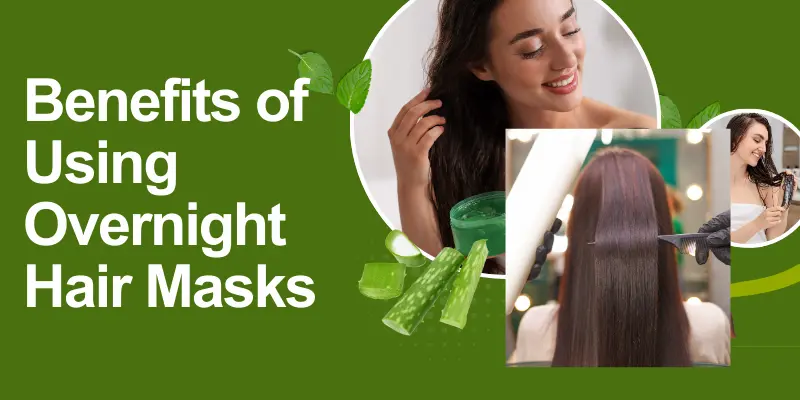DIY Overnight Hair Masks- Restore the Beauty of Your Hair While Sleeping
Published: 21 Nov 2024
Ever dreamt of waking up with luscious, silky hair without spending a fortune on salon treatments? DIY overnight hair masks are your secret weapon. These natural treatments work their magic while you sleep, repairing damage, boosting shine, and deeply moisturizing your strands. Whether you’re battling frizz, dryness, or breakage, there’s a homemade solution tailored just for you.
Benefits of Using Overnight Hair Masks
Overnight hair masks provide extended time for nourishing ingredients to penetrate deeply into the hair shaft.

This prolonged exposure helps in:
- Deep Moisturization: Hydrates dry strands, restoring softness and shine.
- Damage Repair: Strengthens hair, reducing breakage and split ends.
- Frizz Control: Smoothens hair cuticles, taming unruly frizz.
- Enhanced Hair Growth: Stimulates the scalp, promoting healthier hair growth. For effective results, include regular scalp massages and nourishing oils in your routine—top hair growth tips that enhance circulation and support stronger strands.
Over the years, I’ve tried many hair masks, especially when my hair felt dry and lifeless. I’ve learned that not every formula is designed to stay on your hair for long periods. Some recipes work wonders as an overnight treatment, while others can leave your strands feeling heavy, limp, or even cause breakage if the ingredients aren’t suited for overnight use. That’s why it’s essential to consider the benefits and safety of each product carefully. This article will help you find what works for your hair type, based on real results and personal trials.
When I started using DIY options, I found it easy to mix ingredients that truly soothe, soften, and condition the hair without causing damage. An overnight hair mask made from aloe vera and coconut oil became my go-to. It was light, nourishing, and didn’t make my hair feel heavy. If you want real results, try using treatments that are specifically designed for overnight use, not just any mask. Look for recommendations from people who’ve tested them, like me, and avoid those that weren’t created for long-term use. Choose the right formula, and your hair will thank you by morning.
Top DIY Overnight Hair Mask Recipes
DIY overnight hair masks are a budget-friendly way to deeply nourish and repair your hair while you sleep. Many of these masks include ingredients rich in protein for hair repair, helping strengthen strands and reduce breakage. The image below highlights some of the best natural recipes that work well alongside Hair Brushes for optimal results.

Now that you’ve seen these easy and effective recipes, let’s explore how each mask benefits different hair types and how to apply them for maximum overnight impact.
1. Coconut Oil and Honey Mask
Best for: Dry and Rough Hair
Ingredients:
- 2 tablespoons of coconut oil
- 1 tablespoon of honey
Instructions:
- Melt the coconut oil if it’s solid.
- Mix in the honey until well blended.
- Apply to damp hair, focusing on the ends.
- Cover with a shower cap or silk scarf.
- Wash out in the morning with shampoo and conditioner.
| Is It Safe to Sleep in a Hair Mask? |
|---|
|
From my own experience, I’ve found that while hair masks are generally safe for most people, there are some important caveats. Some ingredients, like apple cider vinegar, may seem harmless, but should be avoided for long durations. If left too long, it can strip your hair of protein and cause real damage. I also tried a mask with egg once since it’s a popular choice, but the smell by morning was awful. Worse, it can grow bacteria. Eggs are loaded with protein, which isn’t recommended in an overnight mask. Protein treatments are great, but they should only be used for around 20 minutes. Keeping them on for several hours can make your hair feel heavy and may even cause breakage. So, while hair masks seem like the perfect solution, not all of them are suitable for overnight use. I always check the label now and avoid anything too rich in protein ingredients before going to sleep. Choosing safe options is crucial if your goal is to restore your hair and not damage it. |
2. Aloe Vera and Jojoba Oil Mask
Best for: Oily Scalp and Sensitive Skin
Ingredients:
- 2 tablespoons of aloe vera gel
- 1 tablespoon of jojoba oil
Instructions:
- Mix aloe vera gel with jojoba oil.
- Apply to the scalp in circular motions.
- Tie up your hair and leave it overnight.
- Rinse with a gentle shampoo in the morning.
3. Avocado and Olive Oil Mask
Best for: Damaged or Brittle Hair
Ingredients:
- 1 ripe avocado
- 1 tablespoon of olive oil
Instructions:
- Blend the avocado and olive oil until smooth.
- Apply from mid-lengths to ends, focusing on damaged areas.
- Wrap hair in a shower cap or towel.
- Wash off with shampoo in the morning.
4. Banana and Castor Oil Mask
Best for: Thin or Slow-Growing Hair
Ingredients:
- 1 ripe banana
- 1 tablespoon of castor oil
Instructions:
- Puree the banana until lump-free.
- Mix in the castor oil.
- Apply all over the hair, focusing on roots and tips.
- Cover with a scarf or cap.
- Wash out in the morning.
5. Shea Butter and Argan Oil Mask
Best for: Curly or Textured Hair
Ingredients:
- 1 tablespoon of shea butter
- 1 tablespoon of argan oil.
Instructions:
- Melt the shea butter if solid.
- Mix in the argan oil.
- Apply evenly on wet hair, targeting curls.
- Cover with a silk scarf or bonnet.
- Shampoo in the morning.
Whenever I’m making or buying a hair mask, I always check that the ingredients are well-suited to my hair type or the hair issue I want to address. Once I know the type of mask I’m using and have the ingredients ready, I follow a few easy steps. First, I wash my hair as usual, then gently wring out moisture using a hair turban or towel. To keep things manageable, I divide my hair into sections with large hair clips.
Next, I start at the root and massage the mask into my scalp using my fingers, making sure to coat every strand from root to ends. After it’s applied all over my head, I use a wide-toothed comb to ensure the mask is evenly distributed. If you have long hair, simply wrap it up and secure it with bobby pins. Then, I cover my head with a shower cap or processing cap, and place a towel on my pillow for extra protection in case anything leaks during the night. In the morning, I rinse with a jet of cool or lukewarm water, sometimes several times to fully remove the ingredients.
Application Tips for Best Results
Apply hair masks evenly from roots to ends for thorough nourishment. Use warm towels or heat caps to enhance absorption and boost effectiveness.
Apply to Damp Hair: Enhances absorption of nutrients.
Use a Shower Cap or Silk Scarf: Prevents mess and locks in moisture.

Focus on Ends: Avoid applying heavy oils directly to the scalp unless it’s dry.
Rinse Thoroughly: Use shampoo to remove all residues.
Limit Usage: Apply these masks once or twice a week to prevent buildup.
Conclusion
Incorporating DIY overnight hair masks into your routine is a natural and effective way to rejuvenate your hair. Tailor these recipes to your specific hair needs, and wake up to healthier, shinier locks.
FAQs
Using an overnight hair mask every single night is not recommended because it can lead to product buildup and weigh your hair down. Most experts suggest limiting it to once or twice a week, depending on your hair’s needs. Overnight masks are deeply nourishing, so using them too often may over-moisturize your strands. A balanced routine will keep your hair healthy without making it greasy.
Yes, but the type of oil matters. Light oils such as jojoba, argan, or grapeseed oil are safe for the scalp because they mimic natural sebum and won’t clog pores. Heavier oils like castor or coconut oil should mainly be applied to the mid-lengths and ends, unless your scalp is very dry. Always massage gently to improve circulation and absorption.
Yes, overnight hair masks and oils can sometimes leave stains on pillowcases, especially if they contain strong colors or thick oils. To protect your bedding, it’s best to wear a shower cap, wrap your hair in a silk scarf, or use an old pillowcase. Silk and satin also reduce friction, which helps prevent frizz and breakage while you sleep. This way, your hair and your linens stay safe.
Damp hair is usually the best option for applying an overnight mask because it allows nutrients to penetrate the hair shaft more effectively. The cuticles are slightly open when the hair is damp, which makes absorption easier. However, if you’re using oil-based masks, applying them to dry hair can sometimes provide better coating and protection. Always follow the product or recipe directions.
Not always—if your hair feels soft, silky, and manageable after rinsing the mask, extra conditioning isn’t necessary. Hair masks often provide deeper hydration than conditioners, so doubling up may weigh the hair down. However, if your strands still feel rough, a light conditioner can help lock in moisture. The choice depends on your hair’s texture and response.
For dry hair, a coconut oil and honey mask is one of the best options. Coconut oil penetrates deep into the hair shaft to restore lost moisture, while honey acts as a natural humectant that locks hydration in. Together, they leave your hair softer, shinier, and more manageable. This simple combination is highly effective and works well for all hair textures prone to dryness.
Yes, overnight masks are specifically designed to provide extended hydration and repair while you sleep. By staying on for several hours, the ingredients have more time to penetrate deeply into your strands. This makes overnight treatments ideal for dry, damaged, or chemically treated hair. Just remember to protect your pillow and rinse thoroughly in the morning.
To remove an overnight hair mask, rinse your hair with warm water and shampoo thoroughly. Depending on how heavy the mask is—especially if oils like castor or coconut are used—you may need to shampoo twice. Follow with a lightweight conditioner if needed. This ensures all residue is removed, leaving your hair soft, refreshed, and buildup-free.
Yes, overnight masks can benefit all hair types, but the ingredients you choose should match your hair’s needs. Fine or thin hair does best with lightweight oils like jojoba or aloe-based masks. Thick, coarse, or curly hair may need richer ingredients like shea butter, coconut oil, or castor oil. Tailoring the mask ensures maximum results without weighing hair down.
Overnight hair masks won’t directly speed up hair growth, but they improve scalp health and reduce breakage, which leads to longer, stronger hair over time. Ingredients like castor oil, aloe vera, and rosemary oil are known to stimulate blood flow to the scalp, which supports healthy growth. With consistent use, your hair will appear fuller, thicker, and more resilient.

- Be Respectful
- Stay Relevant
- Stay Positive
- True Feedback
- Encourage Discussion
- Avoid Spamming
- No Fake News
- Don't Copy-Paste
- No Personal Attacks

- Be Respectful
- Stay Relevant
- Stay Positive
- True Feedback
- Encourage Discussion
- Avoid Spamming
- No Fake News
- Don't Copy-Paste
- No Personal Attacks





